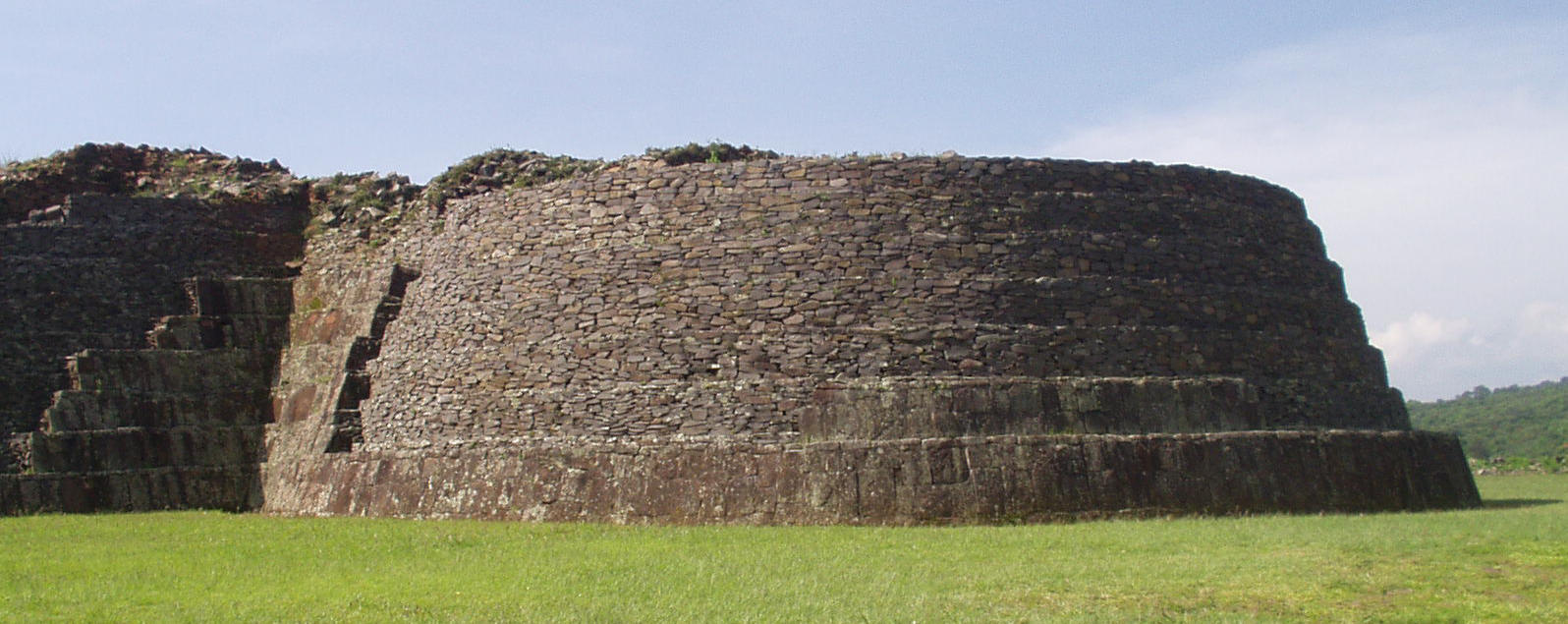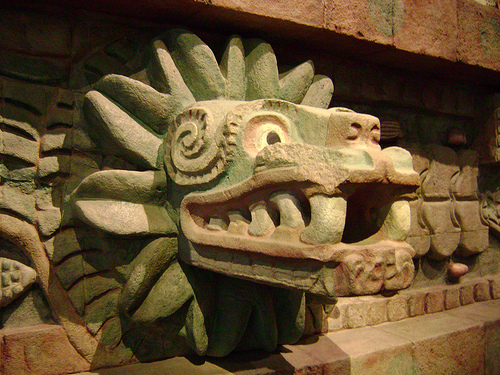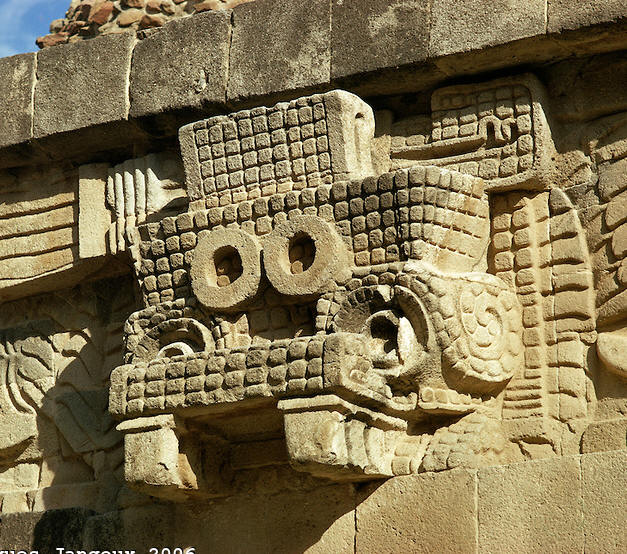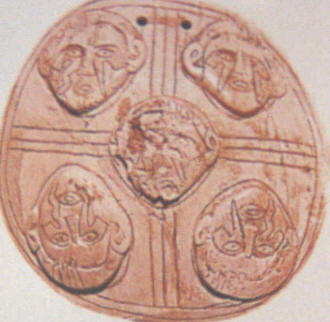Early Nation States in America
Note: Highlighted text is probably a
link. Follow it!
I. Who were the precontact (archaic, PaleoIndian, aboriginal) people of the Northern
woodlands?
A. Earliest people we
know of in any detail lived 4,000 - 1500 BP.
1. Made birdstones
which are hard to date because none have been excavated
in situ.
a. 6" long.
b. Purpose as
handles, weights, "magical" handles?
c. Carved of stone,
holes in the bottom index of age.
d. Frequently
counterfeited.
B.
Adena culture
thrived c. 2,800 - 1,800 BP.
1. Centered in the
central Ohio River Valley.
2. Wattle and Daub
architecture.
3. Indirect (?) trade
with people of:
a. Lake Superior for copper,
b. Gulf Coast for shell,
c. Arkansas, Rockies for obsidian and flint,
d. Tennessee for mica.
4. known for platform
pipes, only 1 known anthropomorph.
5. Slate tablets with
unknown meaning/significance.
a. 10" x 10" x 3/4".
b. Designs emphasize
curvaceous lines and birds of prey.
6. Serpent mound is
not a burial mound, but function obscure.
a. Serpent with
horns? evil water inhabitants?
b. Rain charms?
c. Symbol of
reincarnation (shed skin).
d. Reconstruction and
plowing obscure true base.
7. Practiced the art of skull modification for beauty and for
transformations into were-animals.
C. Hopewell c.
2,300 - 1,400 BP.
1. Started in
Illinois but moved into Ohio River Valley.
2. Mound city near
Chilcothe.
3. Mica-lined grave,
completely lined.
4. Objects
"killed" when owner died.
5. Two-dimensional
art - sheet mica and sheet copper.
6. 4" animal pipes in naturalistic form.
II. Who were the precontact people of the
desert Southwest.
A. The Anasazi are
known by their Navajo name as the Enemies of Our Old Ones.
1. Pueblo peoples prefer the name
hisat sinom.
2. Their towns
shifted from open areas to the cliffs around 1000 BP.
a. As far as we know
they had a democratic form of government.
3. They practiced
agriculture (3
sisters) as borrowed from MesoAmerica.
a. This allowed the
population to increase in times of plenty of rain, but
caused a population decline in times of drought.
i. Serious irrigators with canals and reservoirs.
b. The close ties
with the crops generated many ceremonies.
i. This caused art
and architecture to relate to the crops.
ii. Buildings for
ceremony.
4. Architecture
a. Chaco Canyon
1,100 to 900 BP. Hub of major trade routes. 30' wide roads.
i. Pueblo Bonita "D" shaped complex at least three
stories, maybe five high.
aa. 800 rooms of
masonry covered with plaster housed at least 1,000.
bb. 50 kivas each
with sipapu or place of emergence.
ii. Casa Rinconcada
probably a religious center because of major Kiva.
aa. Principal axis
oriented to summer solstice.
bb. "T" shaped doorways.
b. Betatakin is
the largest cliff overhang dwelling at 1000 A.D.
c. Mesa Verde
National Park contains many ruins.
i. Cliff Palace had
highly decorated walls (geometrics and figurals)
aa. foot drums here.
5.
Pottery.
a. Corrugated ware
for cooking - increased surface area.
b. Grey ware for
storage.
c. Black and
white slipped designs for ollas and burials.
6.
Textiles
a. Tump Line - strap for suspending loads
from the forehead.
b. Called the
Basketmaker culture because of versatile basketry
methods.
c. Clothing men's and
women's
i. Sandals.
ii. Mantas and belts.
iii. Cotton bridal blanket
made by groom.
iv. Hair clubs for
unmarried women.
v. Turkey feather
and rabbit skin blankets.
7. Wiped out by
23 year drought c. 700 BP empty storage bins and houses.
8. Much pot
hunting until 1977.
III. Who were the archaic people of the Valley of
Mexico?
A. Teotihuacan-
Eight sq-mile site located 30 miles NE of Mexico city
2,900 to 1,350 BP
1. We use the Aztec
name for this place and its people. The people who built
this site left wooly mammoth bones which caused the Aztecs to
believe that the people who had built it were giants.
They were not Aztecs, sometimes they are mistaken for the
ancestors of the Toltecs, but this has not proved true.
2. Those who died in
war, childbirth, or drowning went to the highest heaven.
3. Incredible amounts
of remains, new stuff all the time.
. a. Architecture of city
- axial site layout, Camino del Muerto (50 yds. wide) runs
N - S for over a mile, and has a large plaza at the foot
of the Pyramid of the Moon. Walls were typically of the form called
Talud/Tablero. This means there is a narrow table paired with a shot wall. See
picture of curved pyramid wall below.
 |
|
A rare curved pyramid wall. |
i. Pyramid of the Sun
called Southern Structure, currently 210' high.
aa. First built of
all the structures, topped by a temple and idol destroyed
16th century.
bb. E - W
orientation (15E 30 min.) it rests on a platform 1/4
mile an each side. Stairs rise to east marked by
summer solstice.
Talud-tablero
cc. Entirely human
built on flat ground it was over built on ruins. Found a
four room cave beneath this. Origin myth of many peoples.
ii. Ciudadela -
Temple of Quetzalcoatl & Tlaloc.
aa. Discovered under
a newer structure during a repair.
bb. Three-dimensional, tenon heads
of Quetzalcoatl "Quetzal = a bright green bird/feathers; coatl = serpent."
cc. Tlaloc had
massive goggle eyes and jaguar fangs. Streams run from his
hands.
 |
The image above is of Quetzalcoatal. It can be
seen at the
Temple at Teotihuacan. Notice that
he is painted bright green, like
a quetzal bird
feather. Notice the snake fangs, the feathers that
ring his head and the snak spiral in ths side of his
head that
roughly match the spirals on Tlaloc,
seen below. |
 |
This scuplture of Tlaloc with its goggle eyes,
fangs, and corn
kernel skin is also from the
Temple of Quetzalcoatl and Tlaloc at
Teotihuancan. He also wears large ear spools
(gauges) and
bears spirals, similar to those of
Quetzalcoatl, on the sides of
his head. See if
you can spot the seams in between the giant
stones that make up Tlaloc's head. |
a1. Rain deity,
corn deity which required baby tears.
a2. In some locations Tlaloc appears to be a female or else
is replaced by a female deity.
iii. Bordering the
ceremonial centers were
aa. The palaces of
the wealthy. Milk-white stuccoed walls, brilliantly
painted with murals.
bb. Minor civic
centers.
cc. Slightly further
out were multi-family apartment houses.
dd. Artisan centers
include stone carvers, fibers, metal work, feather work.
ee. Market squares
bustled with activity. Great traders.
Traded: animal skins; feathers; seeds; obsidian; gold; silver; quartz;
cotton and agave fibers and textiles; slaves; food; jade; and more.
b. Stone carving.
i. Gigantic sculpture
of Water Goddess over 100 tons found face down near base of
P of Moon. Other colossal sculptures rare, except
stelae.
ii. Smaller sculpture
usually of stone which takes a high polish, basalt,
serpentine, jade, onyx.
aa. One group are small
human figures standing or seated cross-legged. It is
thought many are individual portraits.
iii. The other group
are stone masks.
aa. Use? No eye holes &
too heavy for jewelry
bb. Attempted realism.
Inlaid shell teeth, jewelry
c. Pottery
i. Pottery figurines
found in enormous numbers.
aa. oldest are
pre-classic
bb. Most Classic
figurines were mold made and some molds are still
satisfying tourists desire to collect pseudo-antique
Mesoamerican art.
cc. wheeled feline and
the road issue.
d. Roller stamps.
i. These are rollers with
carved designs on them. They were rolled across a flat surface to achieve a
repeated design.
4. Burned
intentionally 1,350 BP



